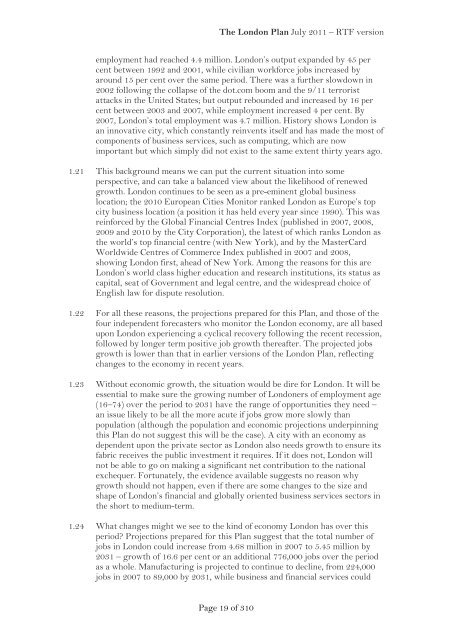London Plan 2011 PDF 1 MB - Lambeth Council
London Plan 2011 PDF 1 MB - Lambeth Council
London Plan 2011 PDF 1 MB - Lambeth Council
You also want an ePaper? Increase the reach of your titles
YUMPU automatically turns print PDFs into web optimized ePapers that Google loves.
The <strong>London</strong> <strong>Plan</strong> July <strong>2011</strong> – RTF version<br />
employment had reached 4.4 million. <strong>London</strong>’s output expanded by 45 per<br />
cent between 1992 and 2001, while civilian workforce jobs increased by<br />
around 15 per cent over the same period. There was a further slowdown in<br />
2002 following the collapse of the dot.com boom and the 9/11 terrorist<br />
attacks in the United States; but output rebounded and increased by 16 per<br />
cent between 2003 and 2007, while employment increased 4 per cent. By<br />
2007, <strong>London</strong>’s total employment was 4.7 million. History shows <strong>London</strong> is<br />
an innovative city, which constantly reinvents itself and has made the most of<br />
components of business services, such as computing, which are now<br />
important but which simply did not exist to the same extent thirty years ago.<br />
1.21 This background means we can put the current situation into some<br />
perspective, and can take a balanced view about the likelihood of renewed<br />
growth. <strong>London</strong> continues to be seen as a pre-eminent global business<br />
location; the 2010 European Cities Monitor ranked <strong>London</strong> as Europe’s top<br />
city business location (a position it has held every year since 1990). This was<br />
reinforced by the Global Financial Centres Index (published in 2007, 2008,<br />
2009 and 2010 by the City Corporation), the latest of which ranks <strong>London</strong> as<br />
the world’s top financial centre (with New York), and by the MasterCard<br />
Worldwide Centres of Commerce Index published in 2007 and 2008,<br />
showing <strong>London</strong> first, ahead of New York. Among the reasons for this are<br />
<strong>London</strong>’s world class higher education and research institutions, its status as<br />
capital, seat of Government and legal centre, and the widespread choice of<br />
English law for dispute resolution.<br />
1.22 For all these reasons, the projections prepared for this <strong>Plan</strong>, and those of the<br />
four independent forecasters who monitor the <strong>London</strong> economy, are all based<br />
upon <strong>London</strong> experiencing a cyclical recovery following the recent recession,<br />
followed by longer term positive job growth thereafter. The projected jobs<br />
growth is lower than that in earlier versions of the <strong>London</strong> <strong>Plan</strong>, reflecting<br />
changes to the economy in recent years.<br />
1.23 Without economic growth, the situation would be dire for <strong>London</strong>. It will be<br />
essential to make sure the growing number of <strong>London</strong>ers of employment age<br />
(16–74) over the period to 2031 have the range of opportunities they need –<br />
an issue likely to be all the more acute if jobs grow more slowly than<br />
population (although the population and economic projections underpinning<br />
this <strong>Plan</strong> do not suggest this will be the case). A city with an economy as<br />
dependent upon the private sector as <strong>London</strong> also needs growth to ensure its<br />
fabric receives the public investment it requires. If it does not, <strong>London</strong> will<br />
not be able to go on making a significant net contribution to the national<br />
exchequer. Fortunately, the evidence available suggests no reason why<br />
growth should not happen, even if there are some changes to the size and<br />
shape of <strong>London</strong>’s financial and globally oriented business services sectors in<br />
the short to medium-term.<br />
1.24 What changes might we see to the kind of economy <strong>London</strong> has over this<br />
period? Projections prepared for this <strong>Plan</strong> suggest that the total number of<br />
jobs in <strong>London</strong> could increase from 4.68 million in 2007 to 5.45 million by<br />
2031 – growth of 16.6 per cent or an additional 776,000 jobs over the period<br />
as a whole. Manufacturing is projected to continue to decline, from 224,000<br />
jobs in 2007 to 89,000 by 2031, while business and financial services could<br />
Page 19 of 310
















